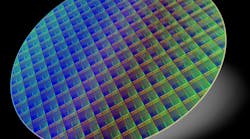In partnership with the University of Massachusetts Amherst, superconductor specialist HYPRES, Inc. fabricated an energy-efficient digital data link between superconducting integrated circuits (ICs) and room-temperature electronic circuits. The team project was part of a Small Business Technology Transfer (STTR) project sponsored by the U.S. Office of Naval Research (ONR).
The project made it possible to achieve extremely high data rates at low signal levels by connecting low-power, cryogenically cooled superconducting ICs with room-temperature circuits and devices. The technique provides a way to reach signal sensitivity well beyond the range of room-temperature electronic circuits and devices.
The HYPRES superconducting ICs are based on single-flux-quantum (SFQ) logic and operate at a cryogenic temperature of 4K and at signal levels that would otherwise be buried by noise in room-temperature circuits and devices. (Note that absolute zero or zero degrees Kelvin, 0K, is equal to −273ºC.) The technology is attractive for electronic applications that can tolerate cryogenic operation or that require energy-efficient, high-speed data operation.
The research team developed a hybrid temperature, heterogeneous-technology (HTHT) data link that distributes signal amplification among electronic stages at different operating temperatures, so that the overall data link can be optimized in terms of size, weight, and power (SWaP) consumption.
“Our approach was to start with the fastest superconductor output driver and connect it to a chain of cryogenic superconductor amplifiers at different temperatures between 4K and 300K,” said Dr. Deepnarayan Gupta, president of HYPRES’ Digital-RF Circuits and Systems business division and the principal investigator of the project. “We have already reached 20 Gb/s data rates per link using this approach, which is better than 14 Gb/s data links achieved without any cryogenic semiconductor amplification.
The HYPRES ADR product line will benefit from technology developed to enhance high-speed data links for the U.S. Navy. (Graphic courtesy of HYPRES Corp.)
“We are now working towards enhancing the data link rate, as well as expanding the number of simultaneous channels with both electrical and optical approaches,” Gupta added. “Better data links are vitally important to the next generation of our Advanced Digital-RF Receiver (ADR) product line (see figure) as well as for future applications, such as for streaming high-speed data processing, for which superconductor electronics offer compelling solutions.”
Professor Joseph Bardin’s group at the UMass Amherst deserves credit for the development of the key technology in the HTHT data link. “We pursued two alternative designs, both using silicon-germanium (SiGe) bipolar transistors,” Bardin explained. “At cryogenic temperatures, these transistors produce higher gain and higher speeds. Through a careful design process, we have optimized the tradeoff between speed and power consumption for our cryogenic integrated circuits. Both designs have met our target performance metrics and now offer different alternatives to HYPRES’ system engineers.”
This combination of higher data communications speeds at lower power levels was well recognized by ONR program officer Dr. Deborah Van Vechten: “ONR encourages partnerships between university research groups and small businesses to harness innovative ideas into practical products. This team has moved through the different phases successfully and has attracted external funding to augment the STTR investment. The HTHT data link is now ready for transition.”


